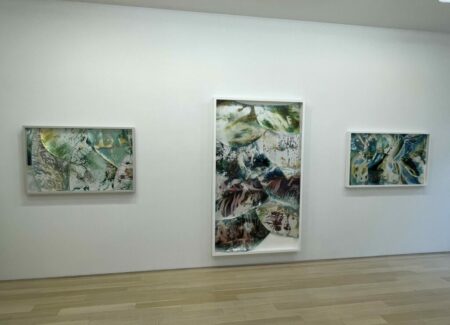JTF (just the facts): A total of 13 photographic works, variously framed/installed, and hung against white walls in the two room gallery space and the entry area. The following works have been included in the show:
- 12 photochemical treatment on RA4 paper, 2023, sized roughly 27x33x3, 31x52x3, 32x49x3, 36x52x3, 47x49x4, 47x63x2, 48x32x3, 49x40x4, 52x50x4, 53x53x2, 82x49x4, 98x44x2 inches, unique
- 1 installation of photochemical treatment on RA4 paper over lightbox, 2023, unique
(Installation shots below.)
Comments/Context: Over the past decade and half, Mariah Robertson has proven herself to be a relentless darkroom experimenter. Starting with the fundamental premise that her work in the darkroom could be boldly improvisational and physically performative, she has explored various techniques and aesthetic approaches, ranging from photogram outlines to expressive chemical washes, building up different visual vocabularies of abstraction.
This show continues efforts that took shape in her last New York gallery show in 2022 (reviewed here), and which reach back to earlier splashy works covered in actively elongated drips, misty washes, and angled watery fluidity. Robertson has also never limited herself to the strict squareness of precisely cut paper, allowing (and encouraging) rips, tears, jagged arcs, and extended rolling billows to help shape her compositions, her unevenly shorn works often framed as floating objects rather than typical photographic prints.
Robertson’s newest works add further refinement to a pair of ideas. The first takes the collage-like layering of prints that she started to explore during the pandemic and expands it into scalloped arrangements of rounded prints that she has laid down like fish scales or snake skin. The second reimagines the paper cutting process, restricting it to the sweeping arc of her arm, which carves out curved edges limited by the end range of her reach; in this way, the cuts aren’t entirely random, but instead follow a loose pattern which results in a repetition of forms. The works on view here remix these two process insights into a selection of mini-projects.
The most conventional of Robertson’s compositions corral various curved scraps into the confines of white rectangular frames. One selection lingers in a palette of blue, green, and yellow, liberally interrupted with white, with the individual pages interwoven and overlapped; this approach allows Robertson to juxtapose different kinds of splashed chemical effects and to twist us around in competing directions. And in a few cases, the curved edges of the papers have been aligned into a kind of sequential progression, with one curve laid atop another in a left to right march. Another group keys off a rainbow of individual background colors, which have been decorated with splotchy starbursts of dripped lightness, vaguely resembling jellyfish floating in the ocean or swirling watery lightning shooting through the sky.
Other works fight back against the geometric constraints (and preconceptions) of wall hung artworks. Some use shaped frames (in various colors) to better match the contours inside the layered works, leading to lozenges and bulbous rounds that are then filled to their edges with Robertson’s active abstractions. And in the back gallery, the prints have left the wall entirely, colonizing the space in the center of the gallery in a sprawling pile set atop a lightbox; the effect is glowingly intermingled, with areas of blue and purple seeming to dominate and small shifts in the air in the gallery ruffling the upturned edges of the prints, giving the installation a minute sense of shimmering motion.
In all of these new works, we find Robertson experimenting with new ways to assemble her darkroom improvisations into finished expressions, trying out alternate modes of physical combination, arrangement, and presentation. The strongest of the works are more than just amalgamations of individual scraps; they become something more integrated and intentionally layered, the shards coming together like the pieces of a puzzle. Energy is directed in competing directions, creating an engrossing sense of kinetic tension.
Collector’s POV: The works in this show are priced between $12000 and $30000, based on size; the installation is NFS. Robertson’s work has little secondary market history at this point, so gallery retail likely remains the best option for those collectors interested in following up.














